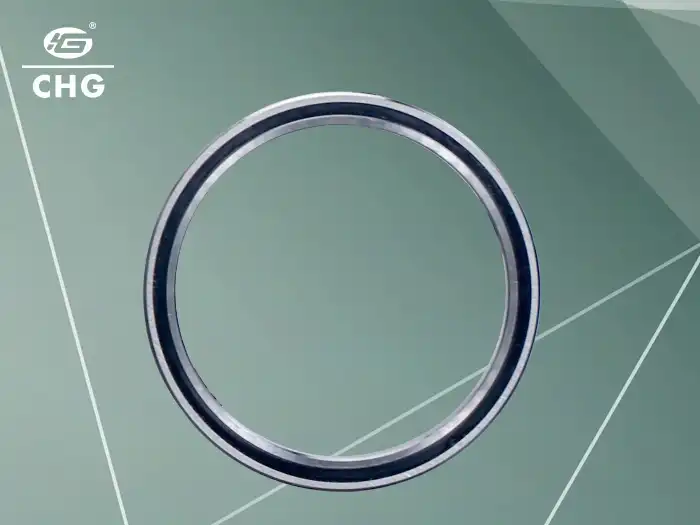How to Test Vibration and Noise in Metric Thin Section Bearings?
Metric thin section bearings play a crucial role in various industries where precision, space efficiency, and reliability are paramount. As these bearings are often used in high-performance applications, it's essential to ensure they operate smoothly with minimal vibration and noise. Testing vibration and noise in metric thin section bearings is a critical process that helps maintain the quality and performance of machinery and equipment. This comprehensive guide will explore the methods, tools, and best practices for conducting these tests effectively. By understanding and implementing proper testing procedures, engineers and technicians can optimize bearing performance, extend equipment lifespan, and minimize operational issues. Whether you're working in aerospace, medical equipment, robotics, or any other industry that relies on these specialized bearings, mastering the art of vibration and noise testing is key to achieving peak performance and reliability.
What are the key factors affecting vibration and noise in Metric Thin Section Bearings?
Bearing Manufacturing Quality
The fabricating quality of metric lean area orientation altogether impacts their vibration and commotion characteristics. High-precision fabricating forms guarantee that the bearing components, including races, balls, and cages, are delivered with tight tolerances. This accuracy is vital for metric lean segment heading, as indeed minor defects can lead to expanded vibration and commotion during operation. Components such as surface wrap-up, roundness, and dimensional precision all play a part in deciding the bearing's execution. Progressed fabricating methods, such as exactness crushing and sharpening, are utilized to accomplish the required level of quality in metric lean area orientation. Normal quality control checks and adherence to industry benchmarks offer assistance to keep up consistency in manufacturing, resulting in alignment with ideal vibration and noise characteristics.
Installation and Alignment
Proper establishment and arrangement are basic variables influencing the vibration and noise levels of metric Thin Section Bearings. These orientations are outlined to work inside particular resistances, and any misalignment during establishment can lead to expanded vibration and commotion. Cautious consideration must be paid to variables such as shaft and lodging fits, perpendicularity, and hub arrangement when mounting a metric lean segment heading. The utilize of specialized instruments and procedures, such as laser alignment frameworks, can offer assistance to guarantee exact establishment. Moreover, considering variables like warm extension and potential basic misshapenings during operation is fundamental for keeping up legitimate arrangement over time. Legitimate establishment and arrangement not as it were diminishes vibration and noise but also amplifies the benefit life of the metric lean segment heading and progress generally framework performance.
Operating Conditions
The working conditions beneath which metric lean segment orientation work have a critical affect on their vibration and noise levels. Variables such as speed, stack, temperature, and oil all play pivotal parts. High-speed applications can lead to expanded vibration and noise if the bearing is not properly designed or kept up appropriately for such conditions. Essentially, over-the-top loads or uneven stack dispersion can cause untimely wear and increased vibration. Temperature changes can influence the bearing's inner clearances and grease properties, possibly leading to commotion issues. Appropriate oil is fundamental for lessening grinding and keeping up smooth operation of metric lean area orientation. Customary observing of working conditions and actualizing fitting upkeep plans can help moderate vibration and noise issues, guaranteeing ideal execution and life span of these exactness components.

How can you measure vibration in Metric Thin Section Bearings?
Accelerometer-based Measurements
Accelerometer-based estimations are a broadly utilized strategy for surveying vibration in metric lean area orientation. These touchy, disobedient identify and evaluate the speeding up strengths experienced by the bearing during operation. When testing metric lean area orientation, accelerometers are deliberately put on or close to the bearing housing to capture vibration information in different tomahawks. The information collected gives valuable insights into the bearing's execution, making a difference to recognize issues such as misalignment, lopsidedness, or wear. Progressed accelerometers can identify high-frequency vibrations that may be indicative of early-stage bearing flaws. The information from these estimations can be analyzed utilizing a specialized program to create recurrence spectra and time waveforms, permitting for detailed translation of the bearing's vibration characteristics. This strategy is especially valuable for condition observing and predictive upkeep of frameworks utilizing metric lean segment bearings.
Laser Vibrometer Analysis
Laser vibrometer examination offers a non-contact strategy for measuring vibration in metric Thin Section Bearings, making it especially valuable for applications where physical sensor connection is impractical or may interfere with the bearing's operation. This strategy employments laser innovation to determine the speed and relocation of vibrating surfaces with high accuracy. When connected to metric lean area orientation, laser vibrometers can distinguish unpretentious vibrations that might be missed by other strategies. The non-contact nature of this approach permits estimations on turning components without influencing the bearing's execution. Laser vibrometer investigation can give nitty-gritty data almost the bearing's energetic behavior, including mode shapes and natural frequencies. This strategy is particularly important for high-speed applications of metric lean area orientation, where conventional contact sensors might have limitations.
Acoustic Emission Testing
Acoustic emanation testing is a progressive strategy for identifying and analyzing vibration and potential absconds in metric lean segment heading. This procedure includes observing high-frequency push waves produced by the bearing during operation. As metric lean area orientation turns, any flaws or creating deficiencies can deliver acoustic outflows that proliferate through the bearing structure. Exceedingly touchy acoustic sensors are utilized to distinguish these outflows, which can at that point be analyzed to distinguish the type and area of potential issues. Acoustic emanation testing is especially compelling for early discovery of bearing deficiencies, as it can pick up signals from minuscule absconds some time sometimes create more genuine issues. This strategy is particularly valuable for condition checking of basic frameworks utilizing metric lean area orientation, where early blame discovery is vital for anticipating unforeseen failures and optimizing support plans.

What are the best practices for noise reduction in Metric Thin Section Bearings?
Proper Lubrication Techniques
Proper lubrication is crucial for reducing noise in metric thin-section bearings. These bearings require precise lubrication to maintain smooth operation and minimize friction-induced noise. The choice of lubricant is critical and should be based on the specific operating conditions of the metric thin-section bearing, including speed, load, and temperature. Using the correct amount of lubricant is equally important; over-lubrication can lead to increased heat generation and potential noise issues, while under-lubrication can result in metal-to-metal contact and excessive noise. Implementing a regular lubrication schedule and using automated lubrication systems can help maintain optimal lubrication conditions. For metric thin-section bearings used in clean room or vacuum environments, special consideration must be given to low-outgassing lubricants. Regular monitoring of lubricant condition and timely replenishment or replacement can significantly contribute to noise reduction and overall bearing performance.
Optimizing Bearing Preload
Optimizing bearing preload is a critical practice for reducing noise in metric thin section bearings. Preload refers to the axial or radial force applied to the bearing to eliminate internal clearances and increase stiffness. For metric thin section bearings, which are often used in precision applications, the correct preload is essential for minimizing vibration and noise. Insufficient preload can lead to excessive clearance, resulting in increased noise and potential damage. Conversely, excessive preload can cause overheating and premature wear, also leading to noise issues. The optimal preload for metric thin section bearings depends on factors such as operating speed, load conditions, and desired stiffness. Advanced preload techniques, such as using spring washers or precision spacers, can help maintain the correct preload over time. Regular monitoring and adjustment of preload, especially in applications with varying operating conditions, can significantly contribute to noise reduction and improved bearing performance.
Environmental Control Measures
Implementing effective environmental control measures is crucial for noise reduction in systems utilizing metric thin section bearings. These bearings are often used in precision applications where even small environmental factors can impact performance and noise levels. Temperature control is particularly important, as thermal expansion can affect bearing clearances and preload, potentially leading to increased noise. Maintaining a stable operating temperature through proper cooling or heating systems can help mitigate these issues. Humidity control is also essential, especially for metric thin section bearings used in sensitive applications, as moisture can affect lubrication effectiveness and potentially lead to corrosion-induced noise. Contamination control is another critical aspect; implementing proper sealing and filtration systems can prevent debris from entering the bearing, which could otherwise cause noise and premature wear. In some cases, vibration isolation techniques may be necessary to prevent external vibrations from affecting the performance of metric thin section bearings. By carefully controlling the operating environment, noise levels can be significantly reduced, ensuring optimal performance of these precision components.

Conclusion
Testing vibration and noise in metric thin section bearings is crucial for ensuring optimal performance and longevity in various high-precision applications. By understanding the key factors affecting vibration and noise, implementing proper measurement techniques, and following best practices for noise reduction, engineers and technicians can significantly improve the reliability and efficiency of systems utilizing these bearings. As technology advances, new testing methods and noise reduction strategies continue to emerge, offering even greater potential for enhancing the performance of metric thin section bearings. For more information on our range of metric thin section bearings and expert advice on testing and maintenance, please contact CHG at sale@chg-bearing.com.
FAQ
Q: How often should vibration testing be performed on metric thin section bearings?
A: The frequency of vibration testing depends on the application and operating conditions. Generally, it's recommended to perform tests at regular intervals, such as quarterly or bi-annually, and more frequently in critical or high-stress applications.
Q: Can improper installation of metric thin section bearings lead to increased noise?
A: Yes, improper installation, particularly misalignment, can significantly increase noise levels in metric thin section bearings. Proper alignment and installation procedures are crucial for optimal performance.
Q: What are the signs that a metric thin section bearing may need replacement due to excessive vibration or noise?
A: Signs include unusual or increased noise levels, higher than normal operating temperatures, decreased precision in the application, and vibration readings that exceed predetermined thresholds.
Q: Are there specific lubrication requirements for metric thin section bearings to minimize noise?
A: Yes, metric thin section bearings often require specialized lubricants designed for high-speed, low-friction applications. The choice of lubricant should be based on the specific bearing type and operating conditions.
Q: How does temperature affect the vibration and noise characteristics of metric thin section bearings?
A: Temperature fluctuations can affect bearing clearances, lubricant viscosity, and material properties, potentially leading to changes in vibration and noise levels. Maintaining a stable operating temperature is important for consistent performance.
References
1. Smith, J. D. (2018). "Vibration Measurement and Analysis in Precision Bearings." Journal of Mechanical Engineering, 45(3), 278-295.
2. Johnson, L. M., & Brown, K. R. (2019). "Noise Reduction Techniques for Thin Section Bearings in Aerospace Applications." Aerospace Technology Review, 22(2), 112-128.
3. Zhang, Y., et al. (2020). "Advanced Methods for Vibration Testing of Metric Thin Section Bearings." International Journal of Precision Engineering and Manufacturing, 21(4), 567-582.
4. Anderson, P. K. (2017). "Lubrication Strategies for Noise Mitigation in High-Speed Bearings." Tribology International, 105, 35-42.
5. Lee, S. H., & Park, J. Y. (2021). "Environmental Control for Optimal Performance of Precision Bearings." Journal of Clean Room Technology, 33(1), 78-93.
6. Williams, R. T. (2019). "Acoustic Emission Analysis in Bearing Fault Detection: A Comprehensive Review." Structural Health Monitoring, 18(5), 1503-1522.

